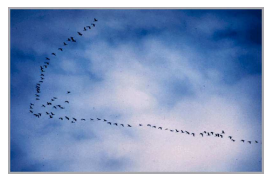2. Fish schools, bird flocks
Fish schools and bird flocks clearly exhibit a structural order, with organisms behavior integrated in a way that they can change in form and direction, they seem to displace as a single coherent entity.
 | ||
| Fish schooling. © CORO, Caltech |
 |
| Birds flocking in V-Formation. © CORO, Caltech |
- Homogeneity: Every bird in flock has the same behavioral model. The flock moves without a leader, even though temporary leaders seem to appear.
- Locality: The motion of each bird is only influenced by its nearest flock mates. Vision is considered to be the most important senses for flock organization.
- Collision avoidance: Avoid with nerby flock mattes.
- Velocity matching: Attempt to match velocity with nerby flock mates.
- Flock centering: Attempt to stay close to nearby flock mates.
 |
| The main principles of collective behavior. |
These systems being characterized by their adaptability and robustness, they can achieve goals that seem unrealizable by a single individual. In fact, in consequence of its decentralized control, every agent react according to its proper perceptions of the modifications of its context and is capable of continually adapting itself to its variations. Also, the number of agents, their interchangeable character, the absence of a centralizing entity make such system tolerant to shortcomings of one of its members.
These two properties allow such system to change the current behavior so that it adapt to the evolutions of its environment and to have a progressive degradation of collective functioning rather than a brutal collapse.



 4/09/2015 08:47:00 pm
4/09/2015 08:47:00 pm
 ZNB
ZNB






0 comments:
Post a Comment